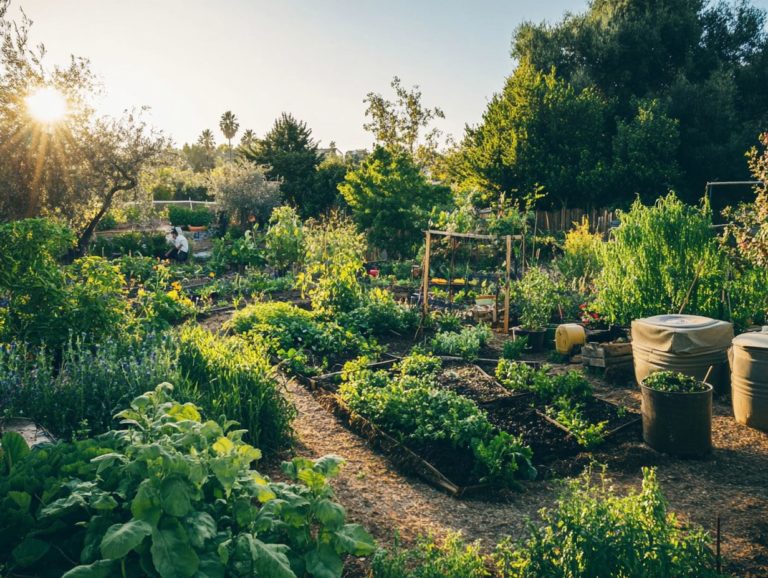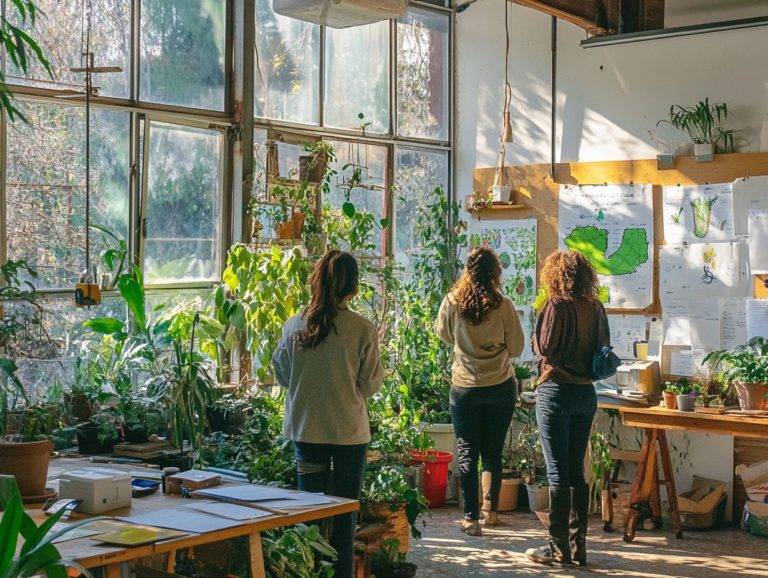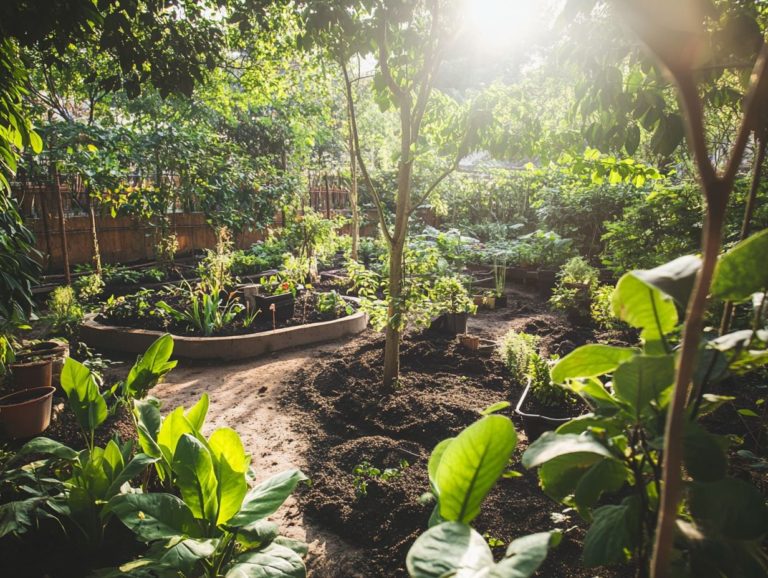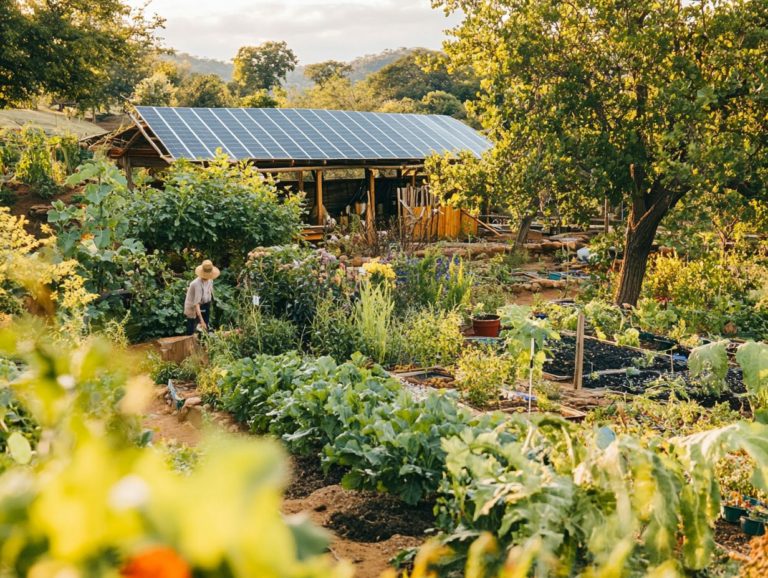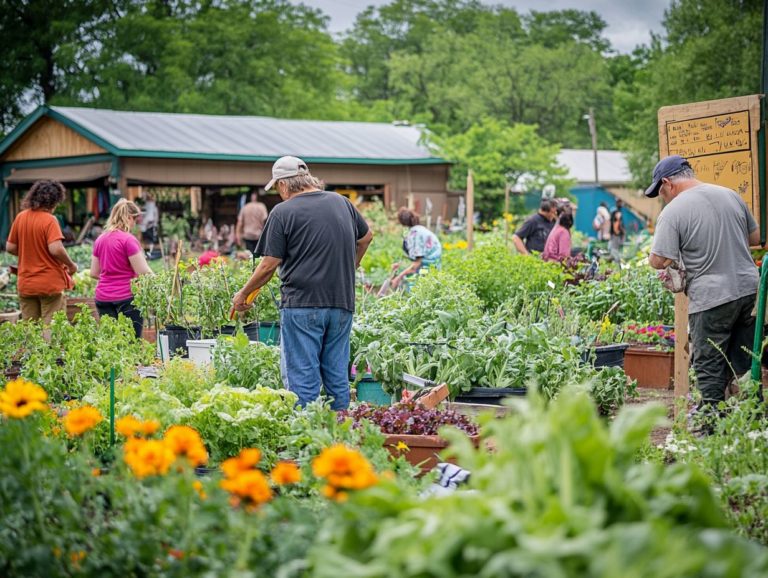How to Integrate Animals in Permaculture?
Permaculture transcends mere gardening techniques; it embodies a holistic approach to sustainable living that champions the harmonious relationship between humans, plants, and animals, creating a thriving natural ecosystem.
Get ready to discover the crucial role animals play within permaculture systems, enhancing soil fertility and promoting biodiversity in remarkable ways.
You ll learn about various types of integrated animals you can incorporate into your design, effective strategies for seamless integration, and essential considerations for their welfare.
By understanding how animals, such as goats, sheep, and ducks, contribute to a thriving ecosystem, you will be inspired to elevate your own permaculture design to new heights.
Contents
- Key Takeaways:
- Understanding Permaculture and the Role of Animals
- Types of Animals Used in Permaculture
- Integrating Animals into Your Permaculture Design
- Benefits of Animals in Permaculture
- Frequently Asked Questions
- What is permaculture and why is it important to integrate animals?
- What are some common animals used in permaculture?
- How do animals contribute to soil fertility in permaculture?
- Can animals in permaculture be raised for food?
- How do you ensure the well-being of animals in permaculture?
- Are there any drawbacks to integrating animals in permaculture?
Key Takeaways:
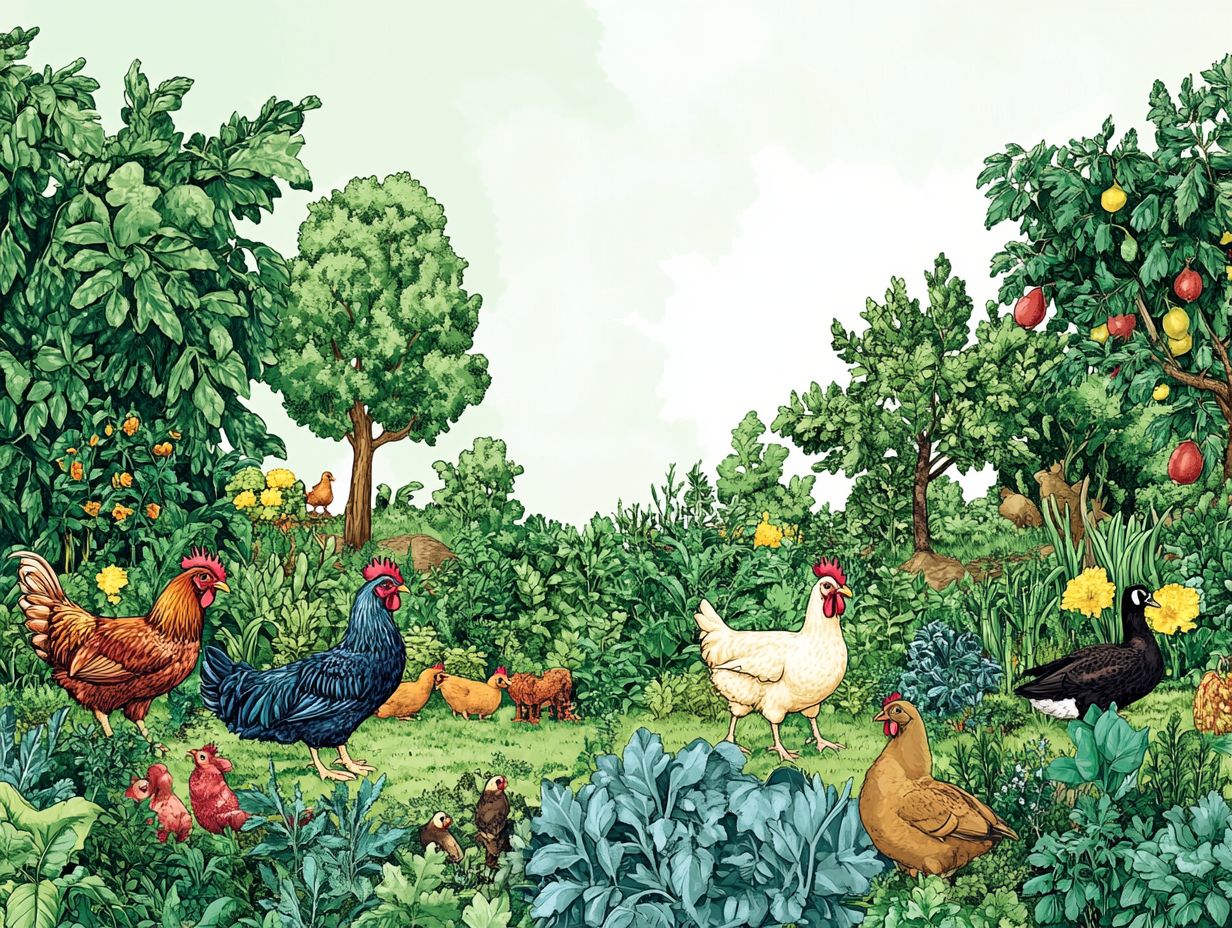
- Animals are your allies in permaculture! They improve soil fertility, control pests, and enhance biodiversity.
- Choose the right animals for your needs, keeping their welfare in mind.
- Whether domestic or wild, understanding the benefits of each type is crucial before you decide.
Understanding Permaculture and the Role of Animals
Understanding permaculture is vital for cultivating a sustainable farming ecosystem that highlights the intricate connections between elements like plants, soil, and animals, including diverse trees and animal products.
In this holistic approach, the role of animals is crucial; they enrich soil health with their manure, boost biodiversity, and engage in a complex web of interactions that nurture a thriving natural ecosystem.
By using methods to manage animals together with plants in farming, such as livestock grazing and poultry control, permaculture aims to replicate nature’s ecological realities. This fosters resilience and self-sufficiency on farms, including places like Keela Yoga Farm in Singapore, known for its innovative approaches to organic farming.
What is Permaculture?
Permaculture is a design philosophy that invites you to create sustainable and self-sufficient agricultural systems by mimicking the intricate relationships found in natural ecosystems. Think food forests and diverse trees as your guiding stars.
At the heart of this approach lie foundational principles that highlight the significance of biodiversity, soil health, and effective water management. These elements come together to cultivate resilient environments.
For instance, when you integrate diverse plant species and animals within the same ecosystem, you enhance nutrient cycling and promote compost creation, all while reducing reliance on synthetic inputs.
Consider real-world applications like incorporating chickens into your vegetable garden. They not only help manage pests but also offer nutrient-rich manure that boosts soil fertility. Similarly, good water management, like using swales or collecting rainwater, is key for sustainability.
These practices foster ecological balance and support the long-term viability of your agricultural systems through farm integration.
Benefits of Integrating Animals
Integrating animals into your permaculture system brings a wealth of advantages, including improved soil microbiology, effective livestock management, and sustainable livestock practices that enhance the resilience of your agricultural ecosystem.
By introducing a variety of species such as chickens, ducks, and goats, you can significantly boost nutrient cycling. These animals contribute organic matter through their waste, enriching your soil in the process while also playing a role in vermiculture compost.
Chickens scratch the soil, aerating it and making it healthier. Ducks, those natural pest control experts, reduce the need for chemical interventions, effortlessly managing pests in your garden.
Look to successful permaculture farms like the renowned Zaytuna Farm in Australia or Polyface Farm. They exemplify these principles, showcasing the harmonious relationship between plants and animals that fosters a thriving environment, prioritizing both biodiversity and sustainability.
Types of Animals Used in Permaculture
In permaculture, both domestic and wild animals like cats, dogs, and geese play essential roles. By including a variety of species such as chickens, pigs, and goats, you can take advantage of their unique abilities for pest control, soil enrichment, and resource management.
This approach enhances the ecosystem and creates a thriving, sustainable environment.
Domestic vs. Wild Animals
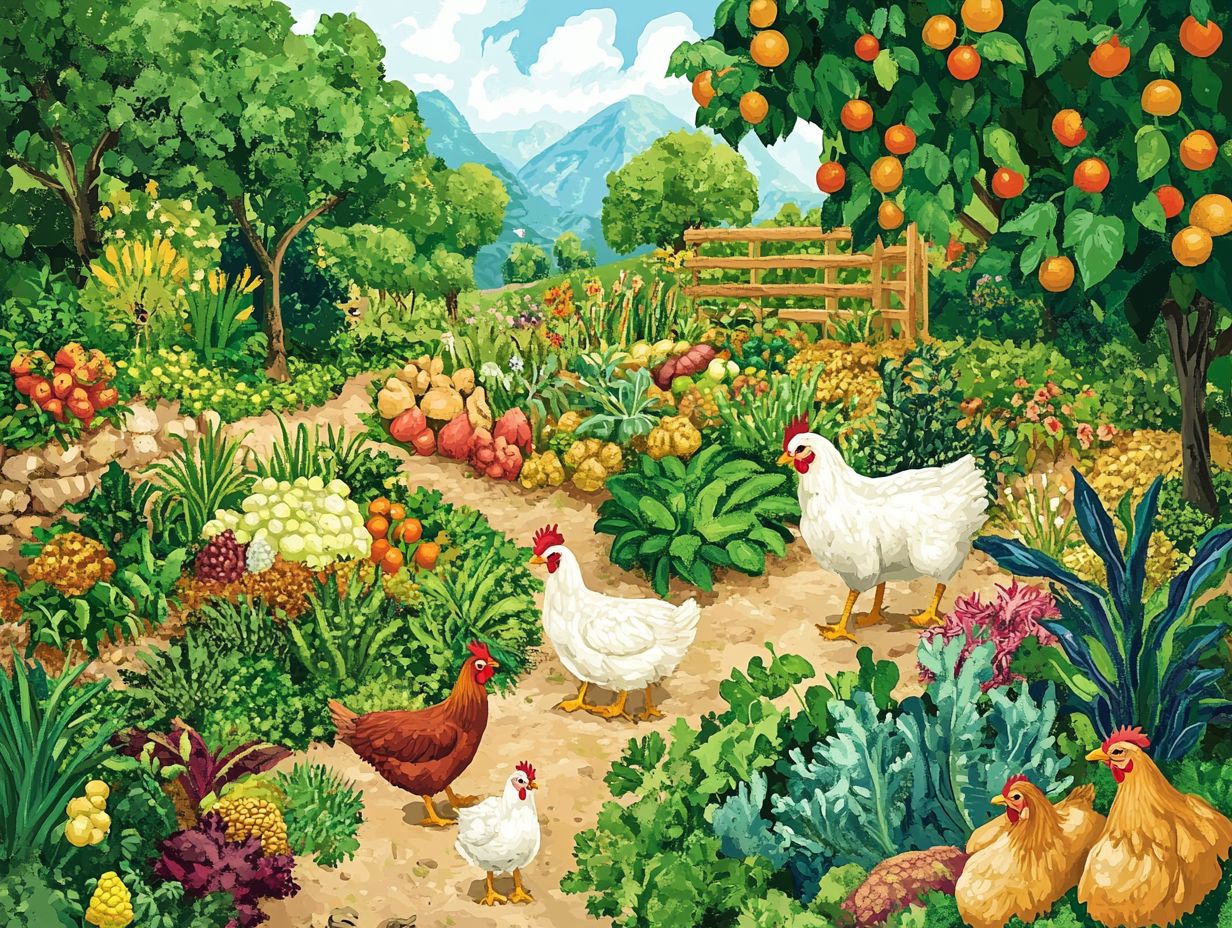
Understanding the difference between domestic and wild animals is crucial. Both types, like pigs and rabbits, contribute uniquely to sustainable farming.
Domestic animals like chickens and pigs are vital, providing manure, pest control, and food production. Chickens enrich the soil with droppings and help manage weeds by foraging. Pigs aerate the ground and manage unwanted vegetation, significantly contributing to the ecosystem.
Wild animals, such as ducks and geese, promote ecological balance by offering pest control and encouraging biodiversity. Their foraging habits manage aquatic weeds and support diverse species.
Together, these animal roles highlight the necessity of integrating both domestic and wild species in permaculture systems, paving the way for a truly sustainable agricultural landscape.
Choosing the Right Animals for Your Permaculture Design
Choosing the right animals for your permaculture design is a crucial step. You need to assess ecological realities alongside your farm’s specific needs.
Evaluate climate conditions, land availability, and resource accessibility to make informed choices. For instance, in a warm, temperate climate, poultry like chickens thrive, offering pest control and nutrient-rich manure. In hilly terrains, goats excel at weed management while enriching the soil.
Consider how your chosen animals will thrive together for a bustling farm! Integrating ducks into rice paddies enhances pest control and improves aeration and nutrient cycling in your water systems. Choosing the right animals boosts your farm s health and productivity!
Integrating Animals into Your Permaculture Design
To successfully integrate animals into your permaculture design, you need a thoughtful strategy that considers the role of animals in permaculture design. This strategy should meet their needs and enhance the ecological contributions of various species within the system.
This delicate balance will elevate your design, fostering a harmonious environment that effectively utilizes food scraps where all elements thrive together.
Strategies for Incorporating Animals
Effective strategies for incorporating animals into your permaculture system include techniques like rotational grazing, establishing a chicken system, and managing different animals together in a way that benefits the farm.
These methodologies enhance biodiversity and promote soil vitality through poultry control. By practicing rotational grazing, you allow livestock to graze on different pasture sections, preventing overgrazing while encouraging robust grass regrowth.
When integrating chickens, they play a vital role by breaking down organic matter and naturally controlling insect populations, reducing your reliance on chemical pesticides.
Animal management fosters a symbiotic relationship among species, creating a balanced ecosystem where nutrient cycling and soil structure thrive. Collectively, these practices improve soil health and support a resilient agricultural environment that champions sustainability.
Considerations for Animal Welfare
Ensuring animal welfare is essential in designing your permaculture system. Healthy and well-cared-for animals, including ducks and goats, play a crucial role in maintaining the ecosystem’s balance and productivity.
This means creating suitable housing that provides shelter and protection from the elements. It should also allow for the flourishing of natural behaviors. By incorporating features that honor the instincts and social structures of various species, including donkeys and sheep, you cultivate a harmonious environment where animals feel safe and content.
Understanding the social dynamics among animals is key. It helps prevent stress while promoting robust breeding and healthier interactions. Ultimately, this enhances the overall resilience of your farm.
These thoughtfully considered practices reinforce the connections between all parts within your permaculture system. This leads to a thriving ecosystem that benefits both animals and plants alike.
Benefits of Animals in Permaculture
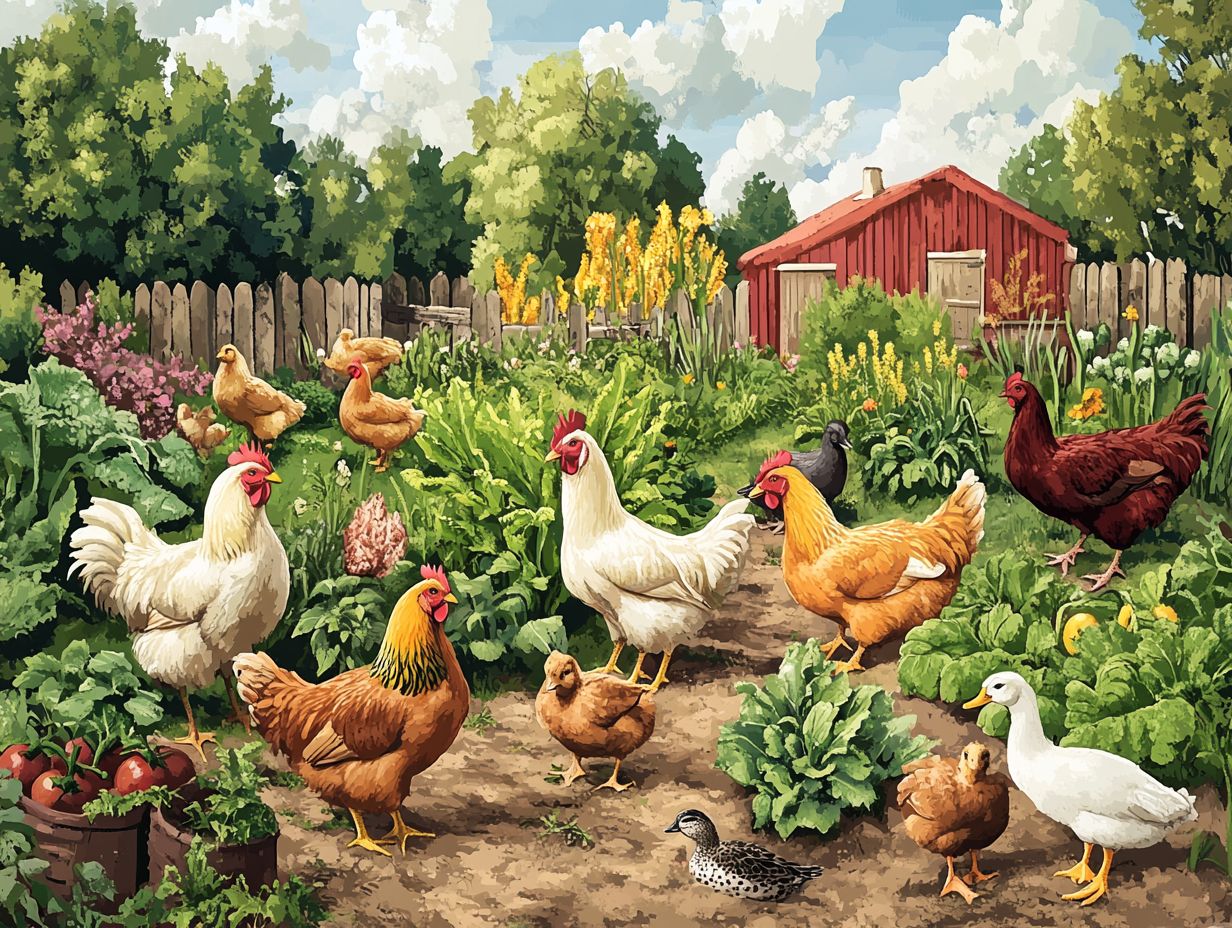
Incorporating animals into your permaculture systems offers an array of benefits that can elevate your agricultural practices. You’ll experience improved soil fertility, enhanced biodiversity, and a more resilient ecosystem that beautifully mimics natural processes.
This approach enriches your environment and fosters a sustainable and harmonious relationship between sustainable farming and nature. Isn t it amazing how animals can transform our landscapes?
Improving Soil Fertility and Pest Control
Animals enhance soil fertility and manage pests. Their organic waste enriches the soil, while their natural behaviors control pest populations.
Take pigs, for example; they are often employed for tilling purposes. Their rooting behavior aerates the soil and incorporates organic matter, promoting healthier microbial activity and ultimately boosting nutrient availability.
Ducks are your allies in pest management. They forage for insects and weeds in rice paddies, significantly reducing the need for chemical pesticides. This benefits crop health and nurtures biodiverse ecosystems.
By fostering the presence of beneficial organisms, animals serve as invaluable partners in organic farming. This showcases a symbiotic relationship that leads to improved yields and a reduced environmental footprint.
Enhancing Biodiversity and Ecosystem Health
Integrating animals into your permaculture systems greatly enhances biodiversity and ecosystem health. It creates a dynamic environment that supports a variety of species and ecological functions.
This holistic approach cultivates a rich tapestry of plants and animals. It fortifies the resilience of your ecosystem against pests, diseases, and climate fluctuations, while promoting worm composting.
Consider the humble bee; its pollination activities are vital for the reproduction of numerous flowering plants, sustaining a balanced food web. Then there are earthworms, the unsung heroes that aerate your soil and break down organic matter, enriching it and facilitating robust plant growth.
Chickens play a pivotal role by managing pests and weeds while enhancing soil health through their natural foraging activities. Together, these interconnected interactions showcase the profound impact that diverse animal species have on maintaining ecological stability and promoting sustainable agricultural practices.
Frequently Asked Questions
What is permaculture and why is it important to integrate animals?
Permaculture is a sustainable design system that aims to mimic natural ecosystems for food production and resource management. Integrating animals in permaculture helps to improve soil fertility, reduce pests, and increase yields.
What are some common animals used in permaculture?
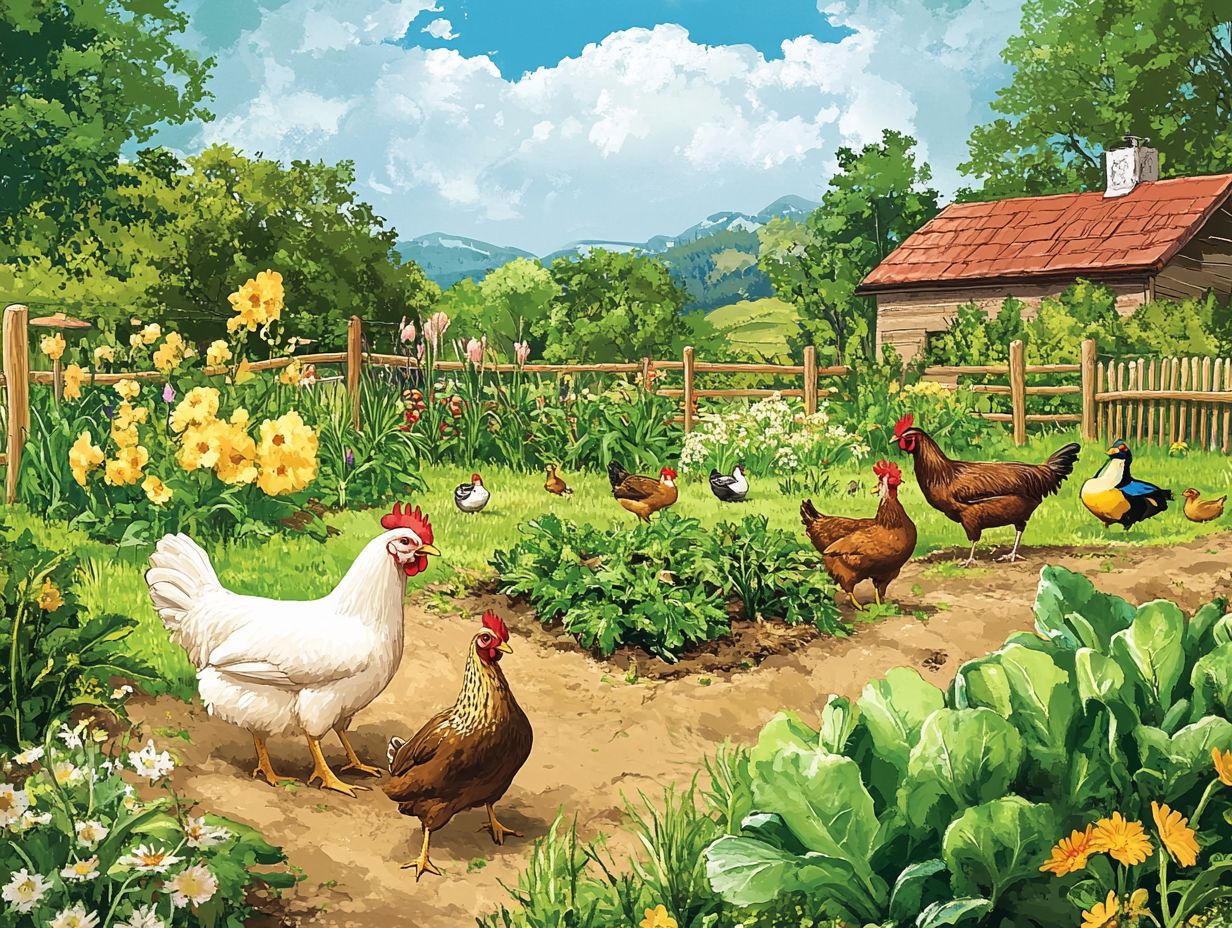
Some common animals used in permaculture include chickens, ducks, goats, pigs, and bees. These animals offer a variety of services such as fertilizing, pest control, and pollination.
How do animals contribute to soil fertility in permaculture?
Animals are essential for soil fertility in permaculture. They provide natural fertilizers through their manure. Their grazing helps aerate the soil and break down organic matter. This improves overall soil health.
Can animals in permaculture be raised for food?
Yes, animals can be raised for food in permaculture. Prioritizing their well-being is crucial for a sustainable approach.
How do you ensure the well-being of animals in permaculture?
To ensure animal well-being, provide proper shelter, food, and water. Consider their natural behaviors by giving them space and enrichment.
Are there any drawbacks to integrating animals in permaculture?
While integrating animals has many benefits, there are some challenges to consider. These include predators, disease, and managing manure. Careful planning is necessary to minimize these issues.


